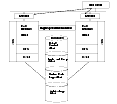|
|
< Previous | Next > |
| Product: Storage Foundation for Oracle RAC Guides | |
| Manual: Storage Foundation 4.1 for Oracle RAC Installation and Configuration | |
What is RAC?Real Application Clusters (RAC) is a parallel database environment that takes advantage of the processing power of multiple computers. A cluster comprises two or more computers, also known as nodes or servers. In RAC environments, all nodes concurrently run Oracle instances and execute transactions against the same database. RAC coordinates access to the shared data for each node to provide consistency and integrity. Each node adds its processing power to the cluster as a whole and can increase overall throughput or performance. RAC serves a critical role in a robust solution for high availability. A properly configured RAC environment can tolerate failures with minimal downtime and interruption to users. If a node fails as clients access the same database on multiple nodes, clients attached to the failed node can reconnect to a surviving node and resume access. Recovery after failure in a RAC environment is far quicker than recovery for a failover database because another instance is already up and running. The recovery process involves applying outstanding redo log entries from the failed node. RAC ArchitectureFrom a high-level perspective, RAC involves multiple Oracle instances accessing a single Oracle database and carrying out simultaneous transactions. An Oracle database is the physical data stored in tablespaces on disk. An Oracle instance is a set of processes and shared memory that provide access to the physical database. Specifically, the instance involves server processes acting on behalf of clients to read data into shared memory and make modifications to it, and background processes to write changed data to disk. In traditional environments, only one instance accesses a database at a specific time. Oracle RAC enhances scalability and availability by enabling multiple instances to access the same database. This requires significant coordination between the instances to keep each instance's view of the data consistent. Click the thumbnail above to view full-sized image. Operating System-Dependent LayerOracle RAC relies on several support services provided by VCS. The important features are cluster membership carried out by the cluster membership manager and inter-node communication. The actual implementation of these functions is described later in this chapter (see Storage Foundation for Oracle RAC OSD Layer Support). Veritas Cluster Server Membership Manager (VCSMM)The Veritas Cluster Server Membership Manager provides a global view of the cluster. VCSMM determines cluster membership and enforces protection of data by preventing nodes outside of the cluster from corrupting stored data. Cluster Inter-Process Communication (VCSIPC)RAC relies heavily on an underlying high-speed interprocess communication mechanism (VCSIPC). This mechanism defines the protocols and interfaces required for the RAC environment to transfer messages between instances. Lock Management and Cache FusionLock management coordinates access for multiple instances to the same data to maintain data consistency and integrity. Oracle's Cache Fusion provides memory-to-memory transfers of data blocks between RAC instances; these transfers are faster than transfers involving writing to and reading from disk across the cluster nodes. Shared Disk SubsystemsRAC requires all nodes have simultaneous access to database storage. This requirement gives multiple instances concurrent access to the same database. |
| ^ Return to Top | < Previous | Next > |
| Product: Storage Foundation for Oracle RAC Guides | |
| Manual: Storage Foundation 4.1 for Oracle RAC Installation and Configuration | |
|
VERITAS Software Corporation
www.veritas.com |
